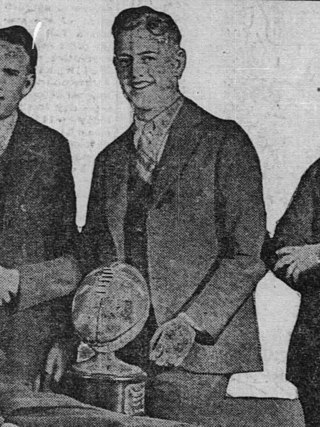Related Research Articles
The 1948 All-Big Nine Conference football team consists of American football players selected to the All-Big Nine Conference teams selected by the Associated Press (AP), United Press (UP) and the International News Service (INS) for the 1948 Big Nine Conference football season. Players selected as first-team honorees by the AP, UP and INS are displayed in bold.
The 1925 All-Big Ten Conference football team consists of American football players selected to the All-Big Ten Conference teams chosen by various selectors for the 1925 Big Ten Conference football season.
The 1927 All-Big Ten Conference football team consists of American football players selected to the All-Big Ten Conference teams chosen by various selectors for the 1927 Big Ten Conference football season.
The 1947 Big Nine Conference football season was the 52nd season of college football played by the member schools of the Big Nine Conference and was a part of the 1947 college football season.
The 1948 Big Nine Conference football season was the 53rd season of college football played by the member schools of the Big Nine Conference and was a part of the 1948 college football season.

The 1901 Western Conference football season was the sixth season of college football played by the member schools of the Western Conference and was a part of the 1901 college football season.
1922 Big Ten Conference football season was the 27th season of college football played by the member schools of the Big Ten Conference and was a part of the 1922 college football season.
The 1924 Big Ten Conference football season was the 29th season of college football played by the member schools of the Big Ten Conference and was a part of the 1924 college football season.

The 1925 Big Ten Conference football season was the 30th season of college football played by the member schools of the Big Ten Conference and was a part of the 1925 college football season. Over the course of the season, Big Ten teams played 36 non-conference games, compiling a 27–9 record (.750) in those games.
The 1938 Big Ten Conference football season was the 43rd season of college football played by the member schools of the Big Ten Conference and was a part of the 1938 college football season.
The 1939 Big Ten Conference football season was the 44th season of college football played by the member schools of the Big Ten Conference and was a part of the 1939 college football season.
The 1940 Big Ten Conference football season was the 45th season of college football played by the member schools of the Big Ten Conference and was a part of the 1940 college football season. The University of Chicago terminated its football program after the 1939 season, leaving only nine conference members fielding football teams. However, Chicago remained a member of the conference and participated in other sports, and the conference remained known generally as the Big Ten.
The 1949 Big Nine Conference football season was the 54th season of college football played by the member schools of the Big Nine Conference and was a part of the 1949 college football season.
The 1950 Big Ten Conference football season was the 55th season of college football played by the member schools of the Big Ten Conference and was a part of the 1950 college football season.
The 1956 Big Ten Conference football season was the 61st season of college football played by the member schools of the Big Ten Conference and was a part of the 1956 college football season.
The 1953 Big Ten Conference football season was the 58th season of college football played by the member schools of the Big Ten Conference and was a part of the 1953 college football season.
The 1951 Big Ten Conference football season was the 56th season of college football played by the member schools of the Big Ten Conference and was a part of the 1951 college football season.
The 1937 Big Ten Conference football season was the 42nd season of college football played by the member schools of the Big Ten Conference and was a part of the 1937 college football season.
The 1920 Big Ten Conference football season was the 25th season of college football played by the member schools of the Big Ten Conference and was a part of the 1920 college football season.
The 1919 Big Ten Conference football season was the 24th season of college football played by the member schools of the Big Ten Conference and was a part of the 1919 college football season.
References
- ↑ "Billy Evans' All-Western Conference Selections". The News-Palladium (Benton Harbor, Michigan). December 1, 1924. p. 5.
- ↑ "Ingram Names Two Hawks On All-Conference". Iowa City Press-Citizen. November 25, 1924. p. 11.
- ↑ "Illinois Student Paper Picks All Conference Team". The Journal News (Hamilton, Ohio). December 1, 1924. p. 34.
- ↑ "Sports Writers Pick Stars of Big Ten Season: Capital Times Dopester Fails to Name Single Badger on First Squad". The Post-Crescent (Appleton, Wisconsin). November 26, 1924. p. 17.
- ↑ W. F. Fox, Jr. (November 29, 1924). "The News' All Conference Selections, 1924". The Indianapolis News. p. 16.
- ↑ Larry Dailey (November 30, 1924). "Grange Only Illini on Dailey's All-Conference Eleven". Decatur Herald. p. 26.
- ↑ "Eckie Selects Big 10 Honor Grid Teams". Chicago Tribune. November 30, 1924.